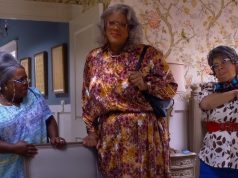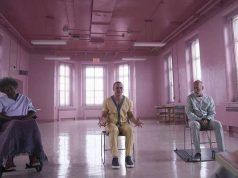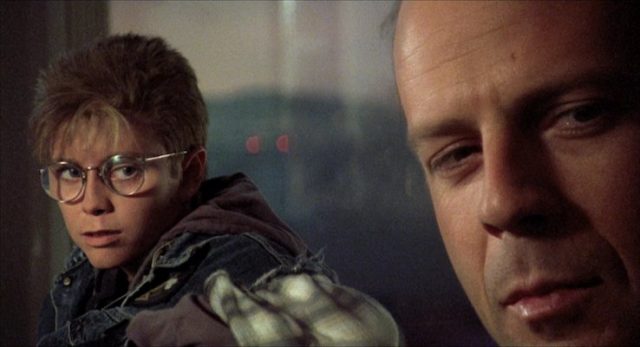
“Color of Night” begins with a pretty woman in a nice dress sobbing while she applies her makeup. She looks like she’s getting ready to go out on a date. But then she smears on her lipstick in a comical fashion, puts a gun in her mouth, and, as she continues to cry, simulates performing a sex act on the gun. In the next scene, she meets with her psychiatrist, which you will agree is a good idea. Alas, she decides to terminate the session by taking a running leap out the office window, smashing through the glass and plunging to her death many stories below.
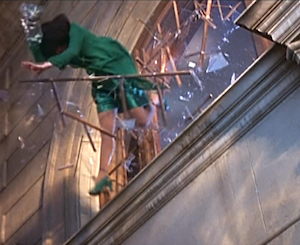
Why has this woman suddenly pulled a Hudsucker? It doesn’t matter! Screw her. The important thing is that it really messes up her psychiatrist, Bill Capa (Bruce Willis), who is unaccustomed to his patients committing suicide right in front of him. Bill is so traumatized by the sight of his patient lying in a pool of blood on the street below that he immediately develops psychosomatic colorblindness and can no longer see the color red. Really! This is the movie’s idea of a deep psychological scar.
So we’re barely 10 minutes into this thing, and already “Color of Night” is a cavalcade of dumb craziness. Can it get any dumber, crazier, or cavalcadier? Surprisingly, yes! Wait’ll I tell you about the man who is clearly a woman in disguise but the movie thinks we won’t notice!
But I have gotten ahead of myself. “Color of Night” came out in 1994, on the heels of erotic thrillers like “Basic Instinct,” “Sliver,” “Jade,” and “Mrs. Doubtfire.” Unlike many erotic thrillers, however, it is neither erotic nor thrilling, though it is sleazy and boring. It belongs to the genre of sleazy borers. Look for that shelf at your local video store! (If you can find your local video store, I mean. Try looking in 2003.)
Bill is shaken up by the colorblindness (and I guess by his patient’s suicide), so he closes his practice and heads to Los Angeles to visit his best friend, Bob (Scott Bakula), a fellow headshrinker. First thing Bob does is invite Bill to sit in on a group therapy session. (“Hey, guys, would you mind if my depressed pal observes this week? Don’t worry, he’s a psychiatrist too! His last client leapt to her death rather than continue to speak with him. Is it cool if he joins us?”) This is Bob’s regular Monday night group, attended by five people with widely varying disorders who do not get along very well and can’t possibly all benefit from the same method of treatment. You know those websites where you can pay fifty bucks and become a licensed minister? That is where Bill and Bob became psychiatrists.
I’m going to list the nutcases in this therapy group. You will need to know them because there’s going to be a murder, and the movie will want to make it seem like each one could be a suspect. You’ve got Sondra (Lesley Ann Warren) the sex addict, Clark (Brad Dourif) the obsessive-compulsive, Casey (Kevin J. O’Connor) the weird artist who’s into bondage and masochism, Buck (Lance Henriksen) the angry guy whose wife and child were murdered, and Richie the stuttering teenage boy with a gender-identity disorder. “Richie the Stuttering Teenage Boy with a Gender-Identity Disorder” is not an old Dana Carvey character from “SNL,” but it should have been.
Richie gets our attention because he is clearly played by a woman. You tend to notice that sort of thing. The woman is Jane March, the British model-turned-actress who only two years earlier had starred in the smutty French movie “The Lover.” “Color of Night” doesn’t want us to realize that Richie is actually a girl at all, much less recognize Jane March as the specific girl that he actually is. “Color of Night” thinks it is pulling a fast one on us! The other characters do not notice that Richie is a girl, the same way everyone in “The Muppets” didn’t notice that Gary’s little brother was a Muppet.
Anyway, Bob gets stabbed to death the next night, right there in his office. The detective working the case, Martinez (Ruben Blades), tells Bill he thinks the murderer is someone from the Monday night group. He would also like Bill to take over the group for Bob, which Bill is reluctant to do because 1) the last patient he treated flung herself through an upper-story window right in front of him, and 2) he heard somewhere that one of the people in the Monday night group might be a murderer. But then he takes over the group after all, because the plot needs him to.
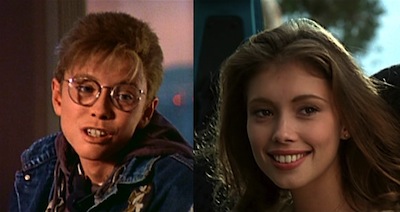
While this is going on, Bill lives in his murdered friend’s spacious home in the Hollywood hills and starts dating a mysterious young woman named Rose. Rose is played by Jane March, whom you will recognize as the woman who also plays Richie the stuttering teenage boy with a gender-identity disorder. Rose and Bill have a lot of steamy sex, which it turns out is the main reason for the movie to exist. Between sex scenes, the movie goes through the therapy participants one at a time, making it look like each of them could have murdered Bob: this one has anger issues, that one has secrets in his past, yada yada. The problem, of course, is that we know none of them is the killer. It was Rose/Richie, obviously, or at the very least someone closely connected to her. (Maybe her brother, Dale, who acts skittish and protective whenever somebody talks to him???) So it’s like an Agatha Christie play, only instead of five equally plausible suspects in a room you have four equally plausible suspects and one suspect who is wearing a sign that says, “YOU SHOULD FOCUS ON ME.”
This is all pretty sleazy and dumb, obviously, but it isn’t sleazy and dumb enough. “Color of Night” has very high standards where sleazy dumbness is concerned. So in a side story, Sondra the sex addict has a lesbian adventure with her friend, Bonnie, who is played by — wait for it — Jane March. And once again, the movie doesn’t want us to notice that Bonnie is the same person as Rose, who is the same person as Richie. The movie is really counting on those sex scenes to distract viewers’ attention. Bonnie wears a blond wig and speaks with a British accent, presumably so attentive audience members will think, “Are Bonnie and Rose the same person?? No, they can’t be, or else they would have the same color hair and speak with the same accent.”
The interesting thing about “Color of Night” is that for such a bad movie, it was very competently made. It was shot and edited by professionals, and it occasionally exhibits signs of artfulness. Which just makes it even weirder that people who ought to have known better would agree to participate in it, since its laughable story and transparent smuttiness doomed it from the start. What a terrible waste of window-smashing and lesbian-adventuring and unconvincing-gender-disguising!
Note: At no point does Bill’s colorblindness factor into the story in any meaningful way. The closest we get is a scene where Bill is driving and he gets a call from someone menacing who says, “I’m in the red car!,” and Bill doesn’t know which car that is. But then the person tries to run him off the road, which helps him narrow it down.
— Film.com


